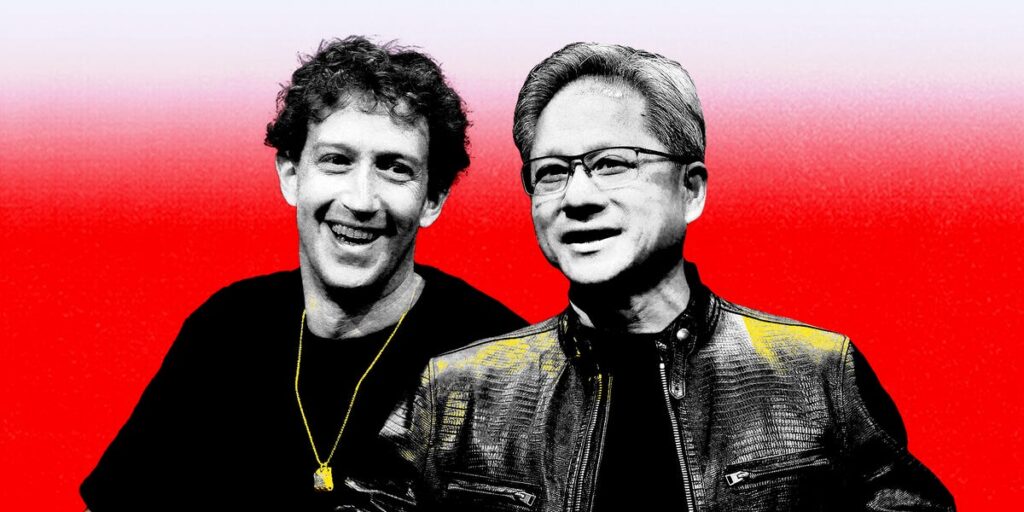Meta CEO Mark Zuckerberg didn’t let the tomatoes touch after he cut them into perfectly uniform slices.
“Just to let you know how OCD he is,” Huang said as he ribbed Zuckerberg for his idiosyncratic food prep at a now infamous cookout the two had at Huang’s house this past spring. A photo of the founders swapping jackets on the day marked the beginning of a bromance, which was on further display Monday at SIGGRAPH 2024, a conference for the graphics industry that increasingly covers AI.
“Look, man, if you wanted them to touch you have to tell me that,” said Zuckerberg.
The meteoric rise of Nvidia’s technology and market capitalization has meant the spotlight that follows the company’s CEO shines on more niche industry events. SIGGRAPH has been serving the graphics industry since 1974, but it’s only now that the technologies behind graphics, augmented reality, and self-driving cars are converging with Nvidia as a focal point, and drawing big names like Zuckerberg at Huang’s invitation.
The two CEOs have a lot in common. They’re both notoriously meticulous. They’re both all-in on AI. They are both keeping quiet on Presidential politics so far. And they’ve both survived many failed business ventures.
“Both of us have gotten kicked in our teeth plenty over the years,” Huang said Monday. But behind the kinship of shared experiences and mutual flattery are billions of dollars of deals, and an increasingly tied future.
Meta is a very good customer
Meta is one of Nvidia’s largest customers. In January, AI-watchers got an early glimpse of the GPU spending spree that had already begun when Zuckerberg revealed the company had purchased roughly 350,000 of Nvidia’s H100 GPUs (or 600,000 GPUs of computing power including non-Nvidia GPUs). At $30,000-$40,000 per chip, a rough estimate puts the total spend around $18 billion. Zuckerberg then forecasted to TheVerge that Meta would likely own 600,000 by the end of this year.
Meta uses those chips to improve its apps via AI-driven content rankings and recommendations, ads tools, and Meta’s AI chatbot, which is fueled by its internal large language model Llama.
“I actually think we’re in a place where we’ve shown that we can build leading models and be the leading AI company in the world,” Zuckerberg told analysts on an April earnings call. “And that opens up a lot of additional opportunities beyond just the ones that are the most obvious for us.”
Meta will report second-quarter earnings on Wednesday afternoon.
Nvidia depends on Meta too
Though there may not be nearly as much, cash flowing from Nvidia to Meta, Zuckerberg’s company is increasingly influential in AI development — especially because it leans toward open-source tools.
“Remember, we all use PyTorch,” Huang said. “That comes out of Meta.” PyTorch is the machine learning tool Meta invented and open-sourced in 2017. It has become the preferred method of building AI tools among machine learning engineers, beating out Google’s TensorFlow. Huang also praised Meta’s work in computer vision, LLMs, and real-time translation.
Huang also mentioned one of Meta’s open-source models, Segment Anything. At the conference, Meta released a new version of the model, which can automatically identify and segment objects and entities within images and videos to make altering graphics faster. Zuckerberg demonstrated the upgrades with a video showing the model selecting cows running across a field on his ranch in Hawaii.
Zuckerberg demonstrated more of Segment Anything’s capabilities later that day in an Instagram video featuring a new gold chain, gifted from artist T-Pain, in which Zuckerberg momentarily disappears from behind the necklace and centers various effects around the large pendant.
Though Huang’s fashion choices, or rather the singular choice of a black leather jacket, are equally iconic, he discussed Segment Anything’s use in robotics.
“Our use case is for robotics and industrial digitalization, and connecting these AI models into omniverse so we can model and represent the physical world better, and have robots operate in these omniverse worlds better,” Huang said.
Huang benefits from Meta’s massive AI infrastructure buildup now, but its future depends on the financial results the tech giants can produce as a result of the immense spending on GPUs. And customers like Meta and Microsoft are at the top of that prove-it list.
“In our company, I want every engineer and every software developer to have an AI or many AIs,” Huang said to Zuckerberg. “The thing that I love about your vision is you also believe that everybody and every company should be able to make their own AI.”
Huang and Zuckerberg have big stakes in that vision coming true, according to Paul Baier, CEO and principal analyst at GAI Insights. Huang needs to ensure LLMs keep building with Nvidia chips and Zuckerberg needs Huang’s credibility to bolster his semi-open-source strategy.
“The bromance will last until the mutual advantage ends,” Baier said.
Got a tip or an insight to share? Contact Senior Reporter Emma Cosgrove at ecosgrove@businessinsider.com or use the secure messaging app Signal: 443-333-9088
Read the full article here
















